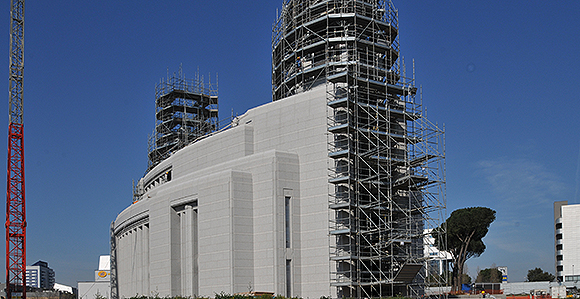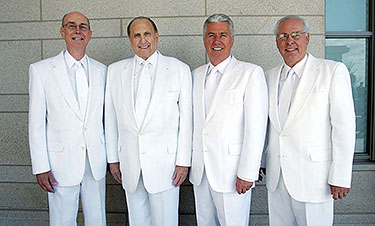Rome Italy Temple Is Landmark of Church Growth
Contributed By By Gerry Avant, Church News editor

Construction is progressing on the Rome Italy Temple; some scaffolding was removed in March. President Thomas S. Monson announced in 2008 plans to build the temple, and he dedicated the site October 23, 2010. It is anticipated the temple will be dedicated in 2015.
Article Highlights
- Work continues on the Rome Italy Temple, and it may be dedicated during 2015.
- Each temple is significant and carries the message of eternal life and forever families, President Monson said.
Work is progressing on the construction of the Rome Italy Temple, one of the most watched and talked about building projects underway by the Church.
President Thomas S. Monson announced plans to build the Rome Italy Temple on October 4, 2008. He dedicated the site and broke ground for the temple on October 23, 2010.
“Much of the exterior scaffolding has been removed, so the beauty of the temple can be seen,” said Elder William R. Walker of the Seventy and Executive Director of the Temple Department. He said a date for the temple’s dedication hasn’t been determined but it might take place sometime during 2015.
The Rome Temple sits on 14.5 acres located at Via de Settebagni, 376, in the northeast corner of the city. It is being constructed primarily of cast-in-place concrete with a Bianco Sardo granite façade; the stone is quarried and fabricated in Italy.
The main building will be 59 feet, 9 inches in height. There are two spires; the west one is to be 138 feet, 6 inches, and the east spire will rise to 156 feet, 3 inches when topped with the statue of angel Moroni.
Temple Department officials said that great care has been taken with the landscaping of the site throughout the project. Stony pines on the site were preserved from existing vegetation, and the olive trees have been relocated throughout the site. Walkways surrounding the temple are constructed of Travertine pavers quarried from various locations throughout Italy.
The primary stone in the interior is Perlato Svevo marble; it is used on the floors, stone base, walls, and countertops throughout the temple. The stone is being quarried in various locations and fabricated in Italy.
A variety of materials will be used on the floors of the temple. Accent stone is used on the floor at the baptistry and the grand stair lobby. The patterns were inspired by Michelangelo's Piazza del Campidoglio located at the top of the Capitoline Hill in Rome. The design includes Michelangelo’s oval design representing the center of the world. Stones used in the floor patterns come from several nations, including Spain, Brazil, and Turkey, as well as Italy.
Carpets in the celestial and sealing rooms will be off-white with carvings reflected in the decorative painting and inspired by the Campidoglio.
Decorative paintings, art glass, millwork, and crown moldings will add to the beauty of the temple.

President Thomas S. Monson and other Church leaders and guests turn shovels of soil at the groundbreaking ceremony for the Rome Italy Temple on October 23, 2010. Photo by Jason Swensen..
The Rome Italy Temple is one of the landmarks of the growth of the Church. Elder Walker said he marvels at that growth and the increasing number of temples, from 10 that had been built by the time he was 12 years old to the 142 that have been dedicated to date. The 143rd, the Fort Lauderdale Florida Temple, will be dedicated May 4.
“When I was 11 years old, the Primary president in our ward (Raymond, Alberta, Canada) said she wanted us to memorize the 13 Articles of Faith and the names and locations of all the temples in the Church by the time we graduated from Primary,” he said. “I had most of the Articles of Faith memorized by that time, and I decided I could learn the names and locations of the nine temples of the Church.”
He already had learned about the temples built in Kirtland, Ohio (1836), and Nauvoo, Illinois, (1846) before the Saints migrated west. Also, he had learned about the four temples built in Utah: St. George (1877), Logan (1884), Manti (1888), and Salt Lake City, (1893), and the ones built in Laie, Hawaii (1919); Cardston, Alberta, Canada (1923); and Mesa, Arizona (1927).
“My great-grandfather Adam Russell attended the dedication of the Salt Lake City Temple. He considered it one of the great moments in his life,” Elder Walker said.

Rome Italy Temple, artist's rendering.
The temple in Idaho Falls, Idaho, was dedicated in 1945, when Elder Walker was just a year old. The last temple on the list, the Bern Switzerland Temple, was dedicated in September 1955, just a few months after his Primary president asked the class to memorize the names and locations of the temples. The Los Angeles California Temple, under construction, was dedicated a year later, in 1956, becoming the tenth temple in the Church.
“Each Primary boy and girl was given a poster about the size of our school notebook paper that had pictures of all the temples in the world,” Elder Walker said. “I hung mine in my bedroom. Imagine how big the poster would have to be today to contain pictures of all 142 temples. Even as Executive Director of the Temple Department, I don’t think I could name all the temples in the Church. Maybe I could if I could look at a map.
“I remember people in the Raymond Ward saying that they had gone to every temple, except the one in Hawaii, during their summer vacation. I don’t think many people could say that today.”
Elder Walker said he has often heard President Monson speak of the remarkable foresight that President Spencer W. Kimball had as he extended the reach of temples throughout the world.
“When President Kimball became President of the Church in 1973, there were only 15 operating temples in the entire world, and the Washington D.C. Temple was under construction,” Elder Walker said.

President Thomas S. Monson, second from left, and his counselors, President Henry B. Eyring, left, and President Dieter F. Uchtdorf, along with Elder William R. Walker of the Seventy, right, stand outside the Oquirrh Mountain Utah Temple between sessions of its dedication in 2009. Photo by Jeffrey D. Allred, Deseret News.
During President Kimball’s 12-year administration (1973–1985), the number of temples had grown to 36, with an additional 9 under construction or announced. “That was three times the number of temples from the time he became President of the Church,” Elder Walker said.
The great work of building temples continued under the direction of President Kimball’s successors: President Ezra Taft Benson, President Howard W. Hunter, and President Gordon B. Hinckley.
“The work of the Lord is rolling forth throughout the earth,” Elder Walker said. “The building of temples has gone forward in a wonderful way under President Monson’s direction. Since becoming President of the Church on February 3, 2008, President Monson has tirelessly crisscrossed the globe in his ministry. Temples have clearly been a very important part of his work and ministry. He has dedicated temples from as far away as Cebu in the Philippines to Kyiv in Ukraine and many places in between. Including the announcements one year ago to build temples in Cedar City, Utah, and Rio de Janeiro, Brazil, he has announced plans to build 33 temples.”
On March 2, President Monson dedicated the 142nd temple, the Gilbert Arizona Temple.
“Wherever I go among the Latter-day Saints, within just a few minutes someone asks me about the Rome Italy Temple,” he said.
Then, he noted that each temple—regardless of its geographical location, size, architectural design, or furnishings—is significant. “Each is the house of the Lord,” he said. “And each carries the message that life is eternal, that a loving Heavenly Father has provided a way whereby we may be together forever as families.”

